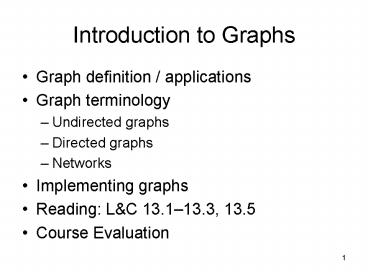Introduction to Graphs - PowerPoint PPT Presentation
Title:
Introduction to Graphs
Description:
Title: Graphs / Course Evaluation Author: Bob Wilson Last modified by: Bob Wilson Created Date: 11/11/2006 5:36:25 AM Document presentation format – PowerPoint PPT presentation
Number of Views:125
Avg rating:3.0/5.0
Title: Introduction to Graphs
1
Introduction to Graphs
- Graph definition / applications
- Graph terminology
- Undirected graphs
- Directed graphs
- Networks
- Implementing graphs
- Reading LC 13.113.3, 13.5
- Course Evaluation
2
Graph Definition/Applications
- A graph is a non-linear structure w/o any root or
parent-child relationships between nodes - Graphs can be used to represent
- Communication or transportation networks
- State diagrams for finite automata
- Prerequisites in a course curriculum
A
B
C
D
3
Problems Solved Using Graphs
- Giving travel directions (Turn right at the gas
station, go though two traffic lights, turn left) - Determining if the graph is connected or not
(Come to think of it now, there aint no way to
get there from here punchline of a joke) - Finding the shortest path across a network (Find
me the lowest airfare from Boston to Hawaii)
4
Graph Terminology
- A vertex is a node in a graph
- Vertices are named or have a label, e.g. A
- An edge is a connection between vertices
- Edges are identified by the pair of vertices that
they connect, e.g. (A, B)
5
Undirected Graphs
- In an undirected graph, the edges have no
direction associated with them - A connection between vertices A and B can be
traversed in either direction - Naming an edge (A, B) is the same as (B, A)
- Two vertices are adjacent if there is an edge
connecting them - Adjacent vertices are also called neighbors
- An edge connecting a vertex to itself is called a
self-loop or sling
6
Undirected graphs
- An undirected graph is considered complete if it
has the maximum number of edges for its number of
vertices - A complete graph is also sometimes called a full
mesh - For n vertices, the number of edges in a complete
graph is equal to n (n - 1) / 2
7
Undirected Graphs
- A path is a sequence of edges between two
vertices - The path length is the number of edges
- An undirected graph is connected if for any two
vertices in the graph, there is a path between
them - If an edge is removed from a graph so that there
is no longer a path between any two vertices, we
say the graph is partitioned
8
Graph Terminology
- A cycle is a path with the same first and last
vertex and with no repeated edges - A graph with no cycles is called acyclic
- A undirected tree is a sub-class of a graph
- A undirected tree is a connected, acyclic,
undirected graph with one element designated as
the root
9
Directed Graphs
- A directed graph also called a digraph is a graph
where the edges are ordered rather than unordered
pairs of vertices - Edge (A, B) is no longer the same as (B, A)
A
B
C
D
10
Networks
- A network or weighted graph is a graph with a
cost or weight associated with each edge - The weight may reflect some physical cost of
using each edge such as the cost for making a
call or the fare for travel between two cities - The weight of a path or the path weight is the
sum of the weights of the edges in the path - Networks may be undirected or directed
- The weight for any missing edge is infinity
11
Implementing Graphs
- Adjacency Lists
- For each node, we maintain a collection of
references to the other nodes with which this
node shares an edge - For a directed graph, the collection contains
references to the other nodes that can be reached
from this node (reverse edge may not be stored in
node at other end) - For a network, the collection contains the other
node and a weight value for the edge
12
Implementing Graphs
- Adjacency Matrices
- Use a two-dimensional array (with weights to
represent a network if required)
Undirected Graph
Undirected Network
A
B
C
A
B
C
D
D
A
F
T
T
0
3
Infinity
F
A
5
B
T
F
T
5
0
2
6
T
B
C
T
T
F
3
2
0
Infinity
F
C
F
T
Infinity
6
Infinity
0
F
D
F
D
13
Final Exam
- Final Exam
- See posted day, time, and location
- It will be 1-1/2 hours not 3 hours
- Watch the website for any late breaking
announcements! - See the posted practice final exam
14
Course Evaluations
- Please fill out the course evaluation forms
- Give to assigned student for turn-in
- Thank you

